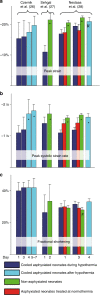Application of Neonatologist Performed Echocardiography in the Assessment and Management of Neonatal Heart Failure unrelated to Congenital Heart Disease
- PMID: 30072802
- PMCID: PMC6257223
- DOI: 10.1038/s41390-018-0075-z
Application of Neonatologist Performed Echocardiography in the Assessment and Management of Neonatal Heart Failure unrelated to Congenital Heart Disease
Abstract
Neonatal heart failure (HF) is a progressive disease caused by cardiovascular and non-cardiovascular abnormalities. The most common cause of neonatal HF is structural congenital heart disease, while neonatal cardiomyopathy represents the most common cause of HF in infants with a structurally normal heart. Neonatal cardiomyopathy is a group of diseases manifesting with various morphological and functional phenotypes that affect the heart muscle and alter cardiac performance at, or soon after birth. The clinical presentation of neonates with cardiomyopathy is varied, as are the possible causes of the condition and the severity of disease presentation. Echocardiography is the selected method of choice for diagnostic evaluation, follow-up and analysis of treatment results for cardiomyopathies in neonates. Advances in neonatal echocardiography now permit a more comprehensive assessment of cardiac performance that could not be previously achieved with conventional imaging. In this review, we discuss the current and emerging echocardiographic techniques that aid in the correct diagnostic and pathophysiological assessment of some of the most common etiologies of HF that occur in neonates with a structurally normal heart and acquired cardiomyopathy and we provide recommendations for using these techniques to optimize the management of neonate with HF.
Conflict of interest statement
AEK is in receipt of an Irish Health Research Board Clinical Trials Network Grant (HRB CTN 2014-10) and an EU FP7/2007-2013 grant (agreement no. 260777, The HIP Trial). AG owned equity in Neonatal Echo Skills and has received grant support from the American Heart Association. DVL is in receipt of an EU FP7/2007-2013 (agreement no 260777 the HIP trial). ED received lecture fees and consulting fees from Chiesi Pharmaceutical. EN received grant support from Research Council of Norway and Vestfold Hospital Trust. KB received lecture fees from Chiesi Pharmaceutical. MB holds a patent, “Thermal shield for the newborn baby. SG received grant support from National Institute of Health Research, Health Technology Assessment (11/92/15), UK. SR received lecture fees for Phillips Ultrasound and GE Ultrasound. WPB has received grant support from The Netherlands Organization for Health and Development (ZonMw; grant number 843002622 and 843002608). ZM has received lecture fees from Chiesi Pharmaceutical. The remaining authors declared no competing interests.
Figures


Comment in
-
Targeted neonatal echocardiography in the United States of America: the contemporary perspective and challenges to implementation.Pediatr Res. 2019 Jun;85(7):919-921. doi: 10.1038/s41390-019-0338-3. Epub 2019 Feb 18. Pediatr Res. 2019. PMID: 30776791 No abstract available.
References
-
- Hsu DT, Pearson GD. Heart failure in children: part I: history, etiology, and pathophysiology. Circ Heart Fail. 2009;2:63–70. - PubMed
-
- Lipshultz SE, et al. The incidence of pediatric cardiomyopathy in two regions of the United States. N. Engl. J. Med. 2003;348:1647–1655. - PubMed
-
- Nugent AW, et al. The epidemiology of childhood cardiomyopathy in Australia. N. Engl. J. Med. 2003;348:1639–1646. - PubMed
-
- Maron BJ, et al. Contemporary definitions and classification of the cardiomyopathies: an American Heart Association Scientific Statement from the Council on Clinical Cardiology, Heart Failure and Transplantation Committee; Quality of Care and Outcomes Research and Functional Genomics and Translational Biology Interdisciplinary Working Groups; and Council on Epidemiology and Prevention. Circulation. 2006;113:1807–1816. - PubMed
-
- Arola A, et al. Epidemiology of idiopathic cardiomyopathies in children and adolescents. A nationwide study in Finland. Am. J. Epidemiol. 1997;146:385–393. - PubMed
Publication types
MeSH terms
LinkOut - more resources
Full Text Sources
Other Literature Sources
Medical
Research Materials
Miscellaneous

